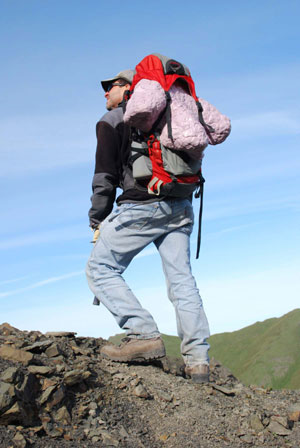 By NED ROZELL August 08, 2009
"Since the first (dinosaur) track was found here in 2005, we've found thousands and thousands of tracks and stuff to go with them," said Fiorillo, with the Museum of Nature & Science in Dallas. He gave a lecture recently at Denali National Park's Murie Science and Learning Center, revealing some of the latest findings from a rich outcrop of rock right off the park road. The area is near where a UAF student, Suzi Tomsich, found the brown-bear-size track of a three-toed meat-eating dinosaur in 2005. "There's a 30-mile section along this road that's full of dinosaur tracks," he said. "This is the exact surface they walked on." The paleontologists have found tracks of duckbilled dinosaurs that include the pebbled skin impression of the dinosaurs' feet. And the three researchers have found large, medium, small duckbilled dinosaur tracks in one prehistoric walkway. "That told us that a bunch of duckbills walked through there, and it showed us duckbills had extended parental care," Fiorillo said. That grouping of large and small tracks also suggests that dinosaurs bred in Alaska. That theory is a point of argument among paleontologists, some who think dinosaurs might have migrated in and out. "We're getting awfully close to saying that they bred here," Fiorillo said. So, what was Denali like during the time of the dinosaurs? The area was at about the same latitude 70 million years ago. So, winters were dark. But, given the recent discovery of the crayfish burrows (Hasiotis found more than 20), and other clues, the area probably had a climate similar to today's Washington state. "The winters weren't anything near what they are today," said Hasiotis, who added that the crayfish burrows also seem to prove there wasn't permafrost in the area 70 million years ago. The scientists have also found freshwater clams, and the petrified leaves of ginkgo, maple, birch, and beech trees, along with horsetails that were probably as high as you are tall. Though the researchers have found no bones, the tracks and fossilized leaves, and the traces of crayfish and clams, are giving them a great picture of Denali in the time of the dinosaurs. And, they're having fun painting that picture, as they explore a place that's a dinosaur-hunter's dream. "This place is loaded," Hasiotis said. "We haven't gone to an outcrop where we haven't seen something." "Every time out, we find something new," said Kobayashi, an associate professor at Hokkaido University.
University of Alaska Fairbanks, in cooperation with the UAF research community. Ned Rozell is a science writer at the institute. Publish A Letter in SitNews Read Letters/Opinions
|
||
